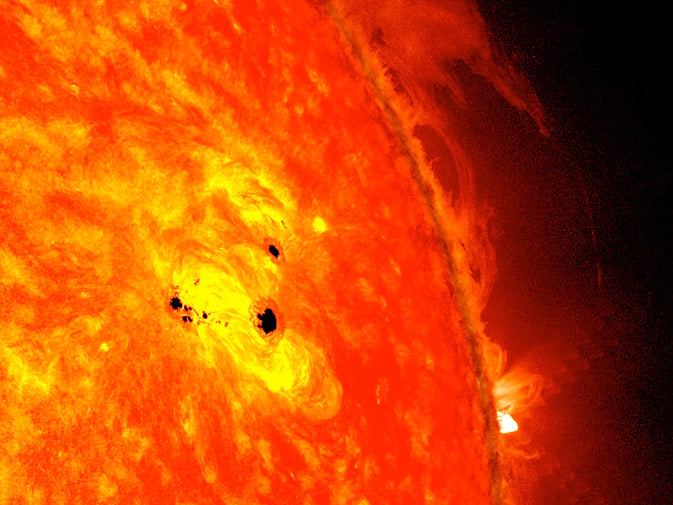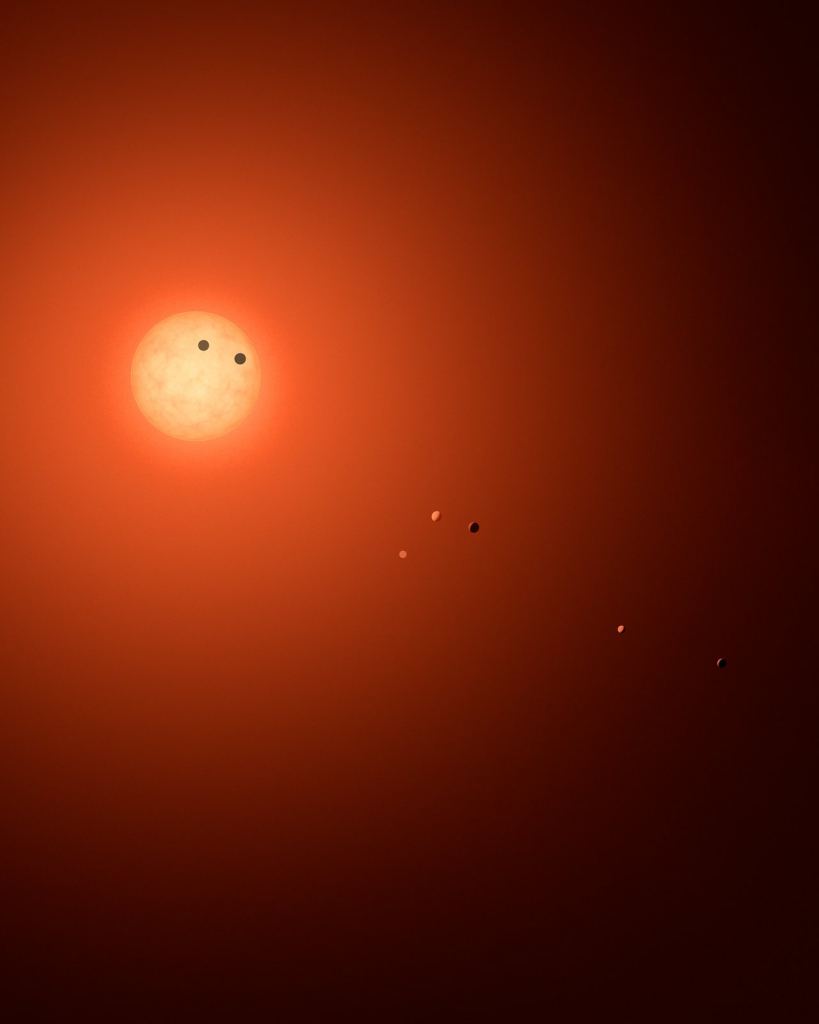Astronomers have discovered another candidate exoplanet orbiting our neighbor, Proxima Centauri. A paper announcing these results was just published in the journal Science Advances. If confirmed, it will be the second exoplanet orbiting the star.
It was big news in 2016 when astronomers discovered a planet orbiting Proxima Centauri (PC,) the nearest star to our Sun. That planet, named Proxima b, is potentially habitable, and at the time there was speculation that we could send a robotic explorer there in only a few decades. The discovery of a second planet, even though it's likely too far away from its star for liquid water, is intensifying interest in the PC system.
The discoverers of this new planet, Proxima c, say that follow-up observations are needed to confirm it as a planet. Changes in the stellar activity of Proxima Centauri indicated the presence of another planet. But they also say that the data they have can't be explained in terms of any stellar activity itself. Due to its proximity, and also its angular separation from the star, it is a prime candidate for follow-up observations—and even imaging—with next generation telescopes.
Proxima c's mass is about half that of Neptune and its orbit is about 1.5 times that of Earth. Its temperature is about -200 C, if it has no atmosphere. Proxima Centauri has undergone intense astronomical scrutiny in the last few years, and that has ruled out the presence of any Jupiter-sized planets between 0.8 and 5+ astronomical units from the star. But finding Proxima c is still surprising, because its presence challenges our models of how super-Earths form and evolve.
The lead author of this study is Mario Damasso from the INAF Astrophysical Observatory of Turin, Italy. The study is titled " A low-mass planet candidate orbiting Proxima Centauri at a distance of 1.5 AU." It was published on January 15th, 2020.
Hugh Jones, a Professor of Astrophysics at Hertfordshire University, was also involved in the study. In an article in "The Conversation," Jones pointed out how difficult it can be to separate data showing the presence of a planet, from data showing stellar activity at the host star. "Just like our sun, Proxima has spots caused by regions of intense magnetic activity which are moving in and out of view, changing in intensity on a variety of timescales. These features need to be considered when searching for any planetary signals."
Even though stellar activity doesn't match the data, the discoverers are being cautious until follow-up observations can either confirm or deny the presence of Proxima c, and definitively rule out stellar activity.
The discovery of this new candidate exoplanet is contained in this new paper, but the history goes back a few years.
Multiple teams of scientists have scoured Proxima Centauri for exoplanets. Much of their work depended on radial velocity data, notably from the ESO's HARPS (High Accuracy Radial velocity Planet Searcher.) Study by study, astronomers have excluded the presence of certain mass-range planets within certain AU ranges from PC.
A 1999 study excluded the presence of any planets beyond 1700 AUs of PC, because PC itself orbits Alpha Centauri AB. A 2019 study set an upper limit of 0.3 Jupiter masses for any planet within 10 AU of PC. That same study excluded the presence of planets between 10 and 50 AU in the mass range 0.3 to 8 masses of Jupiter. Other studies put on more constraints.
But astronomers also know that red dwarfs host more small planets than other types of stars. So they kept looking.
Can We Really Send A Spacecraft There?
The Breakthrough Starshot Initiative (BSI) thinks they can send a tiny spacecraft to Proxima Centauri.
When the Centauri b exoplanet was discovered in 2016, the BSI got to work. They think they can send a nano-spacecraft with cameras to within one AU of the planet and return images much more detailed than we can hope to achieve with any telescope. They say they should be able to return images showing continents and oceans. On their website, BSI says "To achieve comparable resolution with a space telescope in Earth's orbit, the telescope would have to be 300km in diameter."
But even though PC is "close" in astronomical terms, it's still an immense distance away. At 4.2 light years away, it would still take decades to get there, travelling at 20% the speed of light (about 216,000,000 kilometers per hour.) Currently, the fastest spacecraft is NASA's Parker Solar Probe, which will reach a top speed of only 692,000 km/h.
But whether we can get a spacecraft there or not is only part of the story. Due to its proximity, the Proxima Centauri system is an observable laboratory for understanding other solar systems. And its presence and proximity might spur further technological development needed to study it and other systems in more detail.
As Hugh Jones said in his article at The Conversation, "Ultimately, the discovery of multiple signals from the very closest star shows that planets are more common than stars. Proxima represents an excellent location for understanding the closest exoplanets and developing new technologies to better understand the universe we live in."
Proxima c's existence is problematic, or at least significant, for our planet formation models. Among super-Earth planets around low-mass stars detected by radial velocity, Proxima c would have both the longest period and the lowest mass. It would also be the furthest distance from its parent star than the frost line in the original protoplanetary disk. The frost line was probably at 0.15 AU.
The authors say that it's unlikely that Proxima c was kicked out from its initial position closer to the star due to some instability, "because its orbit is consistent with a circular one and because of the absence of more massive planets on shorter orbital distance."
In their paper, they say, "The formation of a super-Earth well beyond the snowline challenges formation models according to which the snowline is a sweet spot for the accretion of super-Earths, due to the accumulation of icy solids at that location."
Proxima Centauri is a red dwarf star, or M dwarf. It's about 4.2 light years away from the Sun, making it our closest neighbour. It's the third star in a trinary system, with the Alpha Centauri AB binary star. Proxima Centauri is about 13,000 AU from Alpha Centauri AB, and was discovered in 1915.
More:
- Research Paper: A low-mass planet candidate orbiting Proxima Centauri at a distance of 1.5 AU
- The Conversation article by Hugh Jones: How we spotted a potential new planet around the sun’s neighbouring star
- Universe Today: Exactly How We Would Send our First Laser-Powered Probe to Alpha Centauri
 Universe Today
Universe Today


